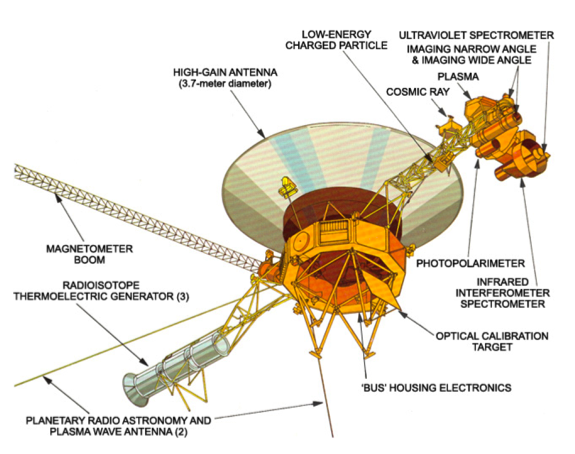- The observations yielded profiles in height of the gas refractivity, molecular number density, pressure, temperature, and microwave absorption in the troposphere and stratosphere of Jupiter at latitudes ranging from 0° to about 70°S.
- The data covered a pressure range from 1000 to 1 mbar over a height interval of 160 km.
- At the 1000-mbar level, the temperature was 165±5 K, and the lapse rate was equal to the adiabatic value of 2.1 K/km, within the resolution of the measurements.
- The ammonia abundance in this region of the atmosphere was about 0.022±0.008%, in approximate agreement with the value derived from cosmic abundance considerations.
- The tropopause, which was detected near the 140-mbar level, had a temperature of 110 K.
- Above the tropopause, the temperature increased with increasing altitude, reaching 160±20 K in the 10- to 1-mbar region of the stratosphere.
- Significant horizontal density variations were detected in the stratosphere. This may imply a non-uniform temperature and aerosol distribution across the Jovian disk or high- and low-pressure regions due to local atmospheric dynamics. The zenoid or gravity equipotential surface which best fits the 100-mbar isobaric surface has an equatorial radius of 71,541±4 km and a polar radius of 66,896±4 km.
- The zenoid or gravity equipotential surface which best fits the 100-mbar isobaric surface has an equatorial radius of 71,541±4 km and a polar radius of 66,896±4 km.

Instrument Characteristics
In the Journal of Geophysical Research – Space Physics, 86, 8721-8727 Lindal et al. state that coherently related S(2.3 GHz) and X band (8.4 GHz) signals transmitted from Voyager 1 and 2 were used to probe the jovian atmosphere during occultations of the spacecraft by Jupiter.
Results for Jupiter stated by Lindal et al.
For Saturn results see The atmosphere of Saturn - an analysis of the Voyager radio occultation measurements Lindal, G. F., Sweetnam, D. N.and Eshleman, V. R., Astronomical Journal (ISSN 0004-6256), vol. 90, June 1985, p. 1136-1146. DOI: 10.1086/113820
The RSS Data
Instrument Description - See Space Science Reviews 21 (1977-Issue 2) 207-232.
There is no atmospheric data available
VG1 dataset for Saturn and Titan are available at Planetary Plasma Interactions
VG2 dataset for Saturn is available at Planetary Plasma Interactions
Voyager 1 PDS4
Voyager 2 PDS4
A hand digitized version of the Voyager 1 Jupiter egress temperature-pressure profile is available
References are
Eshleman, V. R., G. L. Tyler, J. D. Anderson, G. Fjeldbo, G. S. Levy, G. E. Wood, and T. A. Croft, Radio science investigations with Voyager, Space Sci. Rev., 21, 207-232, 1977.
Eshleman, V. R., G. L. Tyler, G. E. Wood, G. F. Lindal, J. D. Anderson, G. S. Levy, and T. A. Croft, Radio science with Voyager 1 at Jupiter: Preliminary profiles of the atmosphere and ionosphere, Science, 204, 976-978, 1979a.
Source: Lindal, G.F., Wood, G.E., Levy, G.S., Anderson, J.D., Sweetnam, D.N., Hotz, H.B., Buckles, B.J., Holmes, D.P., Doms, P.E., Eshleman, V.R., Tyler, G.L., Croft, T.A., 1981, The Atmosphere of Jupiter: An analysis of the Voyager radio occultation measurements, Journal of Geophysical Research – Space Physics, 86, 8721-8727.
Eshleman, V. R., G. L. Tyler, G. E. Wood, G. F. Lindal, J. D. Anderson, G. S. Levy, and T. A. Croft, Radio science with Voyager 1 at Jupiter: Preliminary profiles of the atmosphere and ionosphere, Science, 204, 976-978, 1979a.
Source: Lindal, G.F., Wood, G.E., Levy, G.S., Anderson, J.D., Sweetnam, D.N., Hotz, H.B., Buckles, B.J., Holmes, D.P., Doms, P.E., Eshleman, V.R., Tyler, G.L., Croft, T.A., 1981, The Atmosphere of Jupiter: An analysis of the Voyager radio occultation measurements, Journal of Geophysical Research – Space Physics, 86, 8721-8727.
Publications - A listing of team members to facilitate literature searches.
 PDS: The Planetary Atmospheres Node
PDS: The Planetary Atmospheres Node


